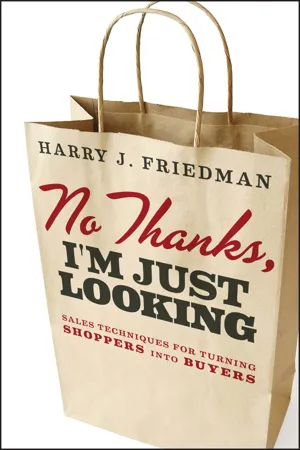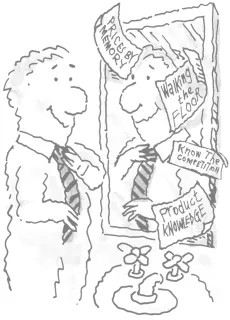![]()
Chapter 1
Getting Your Act Together before You Take It to the Selling Floor
In a March 1989 article, Brian E. Kardon spelled out a new retail term called consumer schizophrenia. He noted that it might be the most important revolution in consumer behavior since the mass-marketing movement of the 1950s.
Simply put, the way people buy could be characterized as schizophrenic. For example:
- You own an expensive imported car but go to a self-service gas station and pump your own gas.
- You buy premium, designer ice cream at the market, and at the same time, buy the house brand dog food or unbranded tissues.
- You buy a custom-made suit, and then go next door and buy toys at discount.
Selling today is remarkably different than it has been in the past, for two major reasons. The first is that people tend to be cautious about where they spend their money, wanting the best quality and the best deal. Second, at the same time that people are careful about spending, there are more consumer goods than ever and greater use of the mass media to advertise them. And then there's the Internet. All this, of course, fosters more competition for the customer's disposable income.
People don't really need a luxury car or a diamond bracelet, but they want that kind of merchandise or desire to use it to express their love or their excitement and joy over special occasions. There is, after all, something exhilarating about finding exactly the right gift for someone or precisely the right piece for yourself. Your goal as a professional salesperson is to create a desire in your customers to want what you have. That is retail selling!
It is no secret that the ingredients for success as a professional salesperson can be summed up in three words:
1. Preparation
2. Preparation
3. Preparation
Preparing your emotional and professional self, knowing your merchandise and price structure, and understanding what your competition is doing—these are all essential to successful selling.
The Not-So-Fun Stuff
In 1974, I became a pilot. Why? I have no idea. It just seemed like the thing to do. In studying to become a pilot, one of the first things I learned was to prepare for each and every flight by doing a precheck, or preflight inspection. The precheck encompasses tasks basic to a pilot's safety, such as checking the gas and oil, making sure the compass is working, seeing that there are no dents or holes in the fuselage, and making other fundamental checks that will keep the plane from falling out of the sky and resulting in pressed aluminum. It really sounded like a good idea to me.
Taking care of these essential items is what helps a pilot grow to a ripe old age. There's a saying in aviation: There are old pilots and bold pilots (a bold pilot referring to a pilot who gets into a plane without checking on the fundamentals), but there is no such thing as an old, bold pilot. Similarly, there are salespeople who flourish and salespeople who are foolhardy, but there are no foolhardy salespeople who flourish for very long.
Many salespeople only want to learn about the perceived important steps of selling, such as how to close, handle objections, and add on. No one likes to do paperwork or stock work; those parts of the job are tedious. But every job has tiresome tasks, which simply have to be done in order to succeed.
In retail selling, performing repetitive and seemingly boring, painstaking precheck chores lay the groundwork for your success on the floor.
Professional retail selling starts with preparation and knowledge; these, in turn, give you self-confidence and control over the selling process.
Some of the elements of preparation take only a few minutes but have to be done every day. This means that you need to arrive at the store well before your shift begins so that you will have time to prepare your plane for takeoff.
Some elements of preparation require a greater investment of time and may have to be undertaken after work or on days off. Long-range preparation, which we will discuss later in this chapter, will help you with your overall approach to your work, as well with your daily precheck.
Whether daily or long range, preparing yourself will help you be the best professional retail salesperson you can be and make you less likely to face a “crash landing” when you are with a customer.
Customer Service Points
Retail is a funny business. We all know that companies that offer high levels of good customer service not only stay in business but also, in most cases, flourish. Those who don't. . .don't. Simple, right?
Wrong! I am consistently amazed as I travel around the world at the number of retail salespeople who offer little or no service to their customers. We all have certain stores or restaurants that we like to frequent because of the service we receive from the people who work there: the waitress at the local coffee shop who calls you by name and knows exactly what you mean when you say, “The usual, Alice,” or the dry cleaner's clerk who knows exactly how you like your clothes cleaned and pressed and makes sure that they are done that way every time, on time.
I recently went to buy a gift for a close friend. This particular store was very busy, so I had the opportunity to observe the salespeople in action prior to making my purchase. There were two salespeople working behind the counter. One was a middle-aged woman, very well dressed and, at first glance, very professional. The other was a younger woman, in her early 20s. She was not dressed to the hilt like her coworker but did have a professional appearance.
As I waited, I observed customer after customer walking away, frustrated by the first woman's actions. She didn't smile, gave short, terse responses to questions, and so on. In contrast, the younger woman was ringing up sale after sale. She had a smile from ear to ear. She used the customers' names. She took the time to gift-wrap the purchase of a man who was in a big hurry. Whom do you think I chose to buy from? No question! There is no substitute for good, basic customer service—period.
I have included 20 customer service points that, through the years, have been proven the most effective in ensuring that your customers feel relaxed and comfortable with you and your store. Try them. Dare to be different.
1. Satisfy Every Single Customer
Retail can become a trap. If you don't sell the customer you're talking to, there is likely to be another one who you can sell, which will make life worth living again. The trap is never being forced to confront why you didn't make the sale with the first customer. It is always more fruitful to learn from your mistakes than from your victories.
Can you look me straight in the eye and tell me without blinking that you have gone for the sale or gone the extra mile with every single customer you have started a conversation with? I doubt it. Shoppers are not and have never been an interruption of your work: they are your work. Heck, they're the only reason you show up in the first place.
I truly believe this is one of the reasons why I have been successful. I could care less what people were going to buy, just that they did. Each one was an opportunity to expand my customer base. And besides, I get cranky when I don't go to the register a lot. The question is, “How good are you?” The answer lies in your ability to turn shoppers into buyers at a high percentage, not just how many dollars you put into the register.
From management's perspective, hundreds of thousands of dollars are spent on merchandising, location, and advertising. It flat-out makes sense to try to sell everyone who comes in, doesn't it? Additionally, as a financial consideration, there is a cost attached to driving each customer in the door. For example, in the piano or hot tub business, it could run as much as $200 in advertising and promotion costs per shopper to get them to come in. In traditional mall stores, the figures may be as low as $10. In either case, for each person you do not sell, that amount is added to the next customer who comes in. So if you didn't make the sale on our piano shopper, that $200 cost is added to the next shopper to come in. That next selling opportunity now costs you $400! You can see how easy it is to go out of business because you didn't try to sell everyone.
2. Keep Personal Problems Off the Floor and in a Drawer
When you're the customer in someone else's store, you expect prompt assistance and courteous treatment—an indication that you are important. Your customers deserve, demand, and expect no less than that, regardless of how you feel personally on a given day.
It's not always easy to adjust your mood, especially if you had a flat tire on the way to work, your teenage children picked an argument with you last night, or you're in the doghouse with your manager. Nevertheless, your customers are entitled to the same very best from you that you are entitled to when you are in someone else's store.
Shoppers can't be expected to care about your personal problems, and if you let your bad day show through, you will leave a poor impression of yourself and your company. The ability to perform regardless of problems has always been a benchmark of the professional.
3. Don't Congregate on the Selling Floor
Picture this: You're in the store on a day that's so quiet you've been listening to the clock tick for amusement. About midmorning, you and your colleagues stand around guarding the register, and get involved in a heated debate about last night's big game. You're so caught up in this vital discussion that you continue talking, although you see that a shopper has come into the store.
She doesn't look like a promising customer; she's not focused on any...

